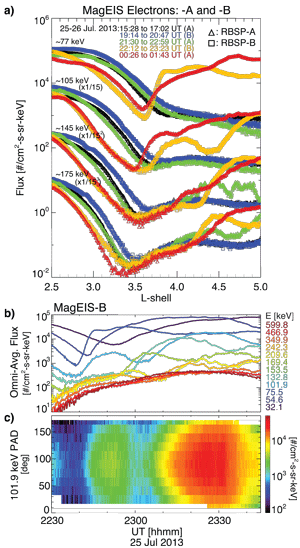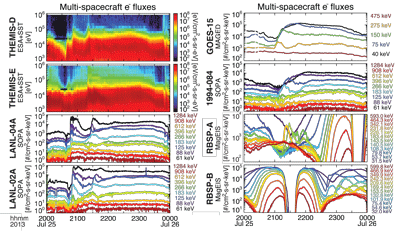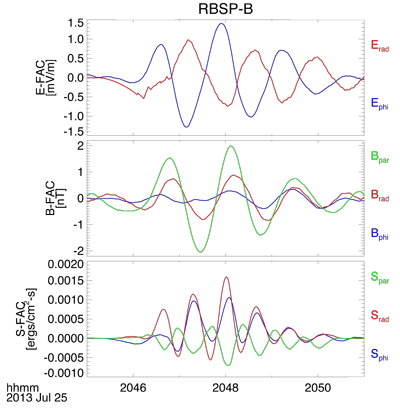
2015 THEMIS SCIENCE NUGGETS
Energetic electron injections deep into the inner magnetosphere associated with substorm activity
by Drew L. Turner
Aerospace Corporation
Introduction
Energetic particle injections [e.g., Gabrielse et al., 2014] involve the sudden inward transport of 10s to 100s of keV electrons and ions from the plasma sheet in Earth's magnetotail into the inner magnetosphere. Such injections are considered to be important to the build-up of Earth's ring current during geomagnetic storms [e.g., Gkioulidou et al., 2014], providing the seed population for the outer radiation belt electrons [e.g., Turner et al., 2014], and the source population of ions and electrons responsible for the generation and growth of various plasma waves [e.g., Li et al., 2013]. In this study, Turner et al. surveyed NASA's Van Allen Probes data from the MagEIS instruments [Blake et al., 2013; Spence et al., 2012] to investigate the depth of energetic particle injections into the inner magnetosphere. A list of all injection signatures that penetrated into L-shell (L) of 4 or lower was compiled, and a detailed case study of one example event was examined using 13 different spacecraft, including NASA's THEMIS mission and the Los Alamos and GOES spacecraft at geosynchronous orbit (GEO), to better understand how electrons can be injected to such low L-shells. Their results are summarized here.
| Figure 1. (a) Electron fluxes from the MagEIS instruments on RBSP-A (triangles) and RBSP-B (squares). Fluxes are plotted versus L shell for different passes through the inner zone, with colors indicating the times of each pass as labeled on the top of the plot; the letters in parentheses next to each time range also corresponds to the spacecraft that made each pass. Distributions from four different energies are shown: 77 keV, 105 keV, 145 keV, and 175 keV. The higher energies have been offset on the Y scale by the factors indicated below each energy label on the plot. (b) A zoomed-in view of the injection signatures in flux versus time as observed down to L ~ 3.5 by RBSP-B. (c) Corresponding pitch angle distributions plotted versus time from RBSP-B for the 101.9 keV energy channel showcasing pitch angle dispersion consistent with localized injections. |
Results
Between December 2012 and September 2013, the first nightside season of the Van Allen Probes, hundreds of energetic particle injections were observed, including 47 that penetrated into L ≤ 4. The lowest such injection was observed down to at least L ~2.5, though it may have penetrated further into the inner radiation belt. From all 47 events, the upper energy threshold of injected electrons never exceeded ~250 keV, and all events were associated with more "classic" injections of electrons observed at higher L-shells. Low-L injection events occurred during both storm and non-storm periods. An example injection event, from 25 July 2013 (non-storm), is shown in Figure 1.
| Figure 2.Electron fluxes from 8 of the 13 spacecraft examined for this event. All data are plotted versus time on the X axis spanning from 20:00 UT on 25 July to 00:00 UT on 26 July 2013. (from top left to bottom right) These include energy fluxes (in color plotted versus energy and time) from THEMIS-D and THEMIS-E, which were located in the near-Earth plasma sheet; flux from LANL-04A, LANL-02A, GOES-15, and 1994-084 at GEO; and flux from RBSP-A and RBSP-B inside of GEO. For the line plots, each color corresponds to a different differential energy channel, with the corresponding channel equivalent energies listed on the right of each plot. The instruments used to make the observation are listed under each spacecraft name. |
The 25 July 2013 event provided a good opportunity to study such injections using multi-point observations. Using data from THEMIS, LANL-GEO, GOES, and Van Allen Probes, as shown in Figure 2, the injection to lower L-shells (down to L~3.5), observed by RBSP-B, was apparently associated with injections that were observed before at higher L, first by THEMIS in the near-Earth plasma sheet, next by LANL-GEO and GOES around L~6.6, and then by RBSP-A near the plasmapause around L~5. These observations are summarized in Figure 2.
| Figure 3.Wave data from RBSP-B around the time the dispersionless injection was observed by LANL-04A at GEO. (from top to bottom) The panels show the electric field (E), magnetic field (B), and Poynting vector (S) in field-aligned coordinates. The background E and B fields have been subtracted, and the data have been filtered to remove the spacecraft spin frequency. For E, only the two perpendicular components, radial (positive earthward) and azimuthal (positive westward), are shown (in red and blue, respectively), since the E field observations assumed E x B = 0. For B and S, the field-aligned (parallel/compressional) component is shown in green. These results are consistent with these waves being fast magnetosonic waves with energy propagating mostly earthward and westward when they were observed within the plasmasphere (L ~ 2.5) on the nightside by RBSP-B. |
Turner et al. used the 25 July 2013 event to investigate how electron injections can penetrate to such low L. They discounted injection due to enhanced global convection since the injections down to L~3.5 occurred within the plasmasphere. Next, they investigated whether the theory of localized dipolarization fronts and earthward surging plasma bubbles from reconnection in the magnetotail could result in a direct injection of electrons to such low L. They used the THEMIS observations of the dipolarizations in the plasma sheet to estimate the flux tube entropy [e.g., Wolf et al., 2006] of the dipolarized plasma and compared it to flux tube entropy calculated from the Van Allen Probes data. They found that the injections may have penetrated into RBSP-A's location at L~5, but should not have penetrated further into L~3.5, where their signatures were observed by RBSP-B. Finally, using data from the EMFISIS [Kletzing et al., 2013] and EFW [Wygant et al., 2013] instrument suites on Van Allen Probes, Turner et al. were able to identify Pi 2 electromagnetic waves (period ~80 s) that occurred around the time that the first injection was observed by THEMIS and LANL-04A in the post-midnight local time sector. These waves, shown in Figure 3, were consistent with plasmaspheric cavity mode waves [e.g., Takahashi et al., 2003] that may have been generated by the injection breaking and interacting with the plasmapause at higher L-shells. Furthermore, Turner et al. speculated that the azimuthal component of the electric field associated with these waves may have resulted in the inward radial transport of lower energy (10s to ~200 keV) electrons within the plasmasphere, and in the presence of strong radial gradients in the electron distributions in L-shell, as is indeed the case in the slot region between the inner and outer radiation belts, any inward transport would manifest itself as a sharp increase in electron fluxes at lower L.
Conclusion
Turner et al. showed that energetic electrons ranging in energy from 10s to ~250 keV can be injected deep into the inner magnetosphere (L ≤ 4) during substorm activity. They speculated that these injections do not result from the same mechanism that causes "classic" energetic particle injections at higher L-shells (outside of the plasmasphere). Instead, these injections may result from wave-particle interactions between ULF waves in the Pi 2 frequency range inside the plasmasphere and lower energy electrons in the slot region. The exact mechanism of such injections remains an open question to be investigated further in future observational studies and modeling efforts. Low-L injections should be important to inner magnetospheric dynamics, as they provide an activity-dependent source of the inner zone electron population [e.g., Fennell et al., 2015] and may disrupt coherent structures in the inner zone particle populations [e.g., "zebra stripes", Ukhorskiy et al., 2014].
Reference
1. Blake, J. B., et al. (2013), The Magnetic Electron Ion Spectrometer (MagEIS) instruments aboard the Radiation Belt Storm Probes (RBSP) spacecraft, Space Sci. Rev., doi:10.1007/s11214-013-9991-8.2. Gabrielse, C., et al. (2014), Statistical characteristics of particle injections throughout the equatorial magnetotail, J. Geophys. Res., 119, doi:10.1002/2013JA019638.
3. Gkioulidou, M., et al. (2014), The role of small-scale ion injections in the buildup of Earth's ring current pressure: Van Allen Probes observations of the 17 March 2013 storm, J. Geophys. Res., 119, doi:10.1002/2014JA020096.
4. Kletzing, C., et al. (2013), The Electric and Magnetic Field Instrument Suite and Integrated Science (EMFISIS) on RBSP, Space Sci. Rev., doi:10.1007/s11214-013-9993-6.
5. Li, W., et al. (2013), An unusual enhancement of low-frequency plasmaspheric hiss in the outer plasmasphere associated with substorm-injected electrons, Geophys. Res. Lett., 40, doi:10.1002/grl.50787.
6. Spence, H., et al. (2013), Science goals and objectives of the Energetic particle, Composition, and Thermal plasma (ECT) suite on NASA's Radiation Belt Storm Probes (RBSP) mission, Space Sci. Rev., doi:10.1007/s11214-013-0007-5.
7. Takahashi, K., D.-H. Lee, M. Nose´, R. R. Anderson, and W. J. Hughes (2003), CRRES electric field study of the radial mode structure of Pi2 pulsations, J. Geophys. Res., 108(A5), 1210, doi:10.1029/2002JA009761.
8. Turner, D. L., et al. (2014), Competing source and loss mechanisms due to wave-particle interactions in Earth's outer radiation belt during the 30 September to 3 October 2012 geomagnetic storm, J. Geophys. Res., 119, doi:10.1002/2014JA019770.
9. Ukhorskiy, A. Y., et al. (2014), Rotationally driven ‘zebra stripes' in Earth's inner radiation belt, Nature, 507, doi:10.1038/nature13046.
10. Wolf, R. A., et al. (2006), Estimating local plasma sheet PV5/3 from single spacecraft measurements, J. Geophys. Res., 111, A12218, doi:10.1029/2006JA012010.
11. Wygant, J. R., et al. (2013), The Electric Field and Waves instruments on the Radiation Belt Storm Probes mission, Space Sci. Rev., doi:10.1007/s11214-013-0013-7.
Biographical Note
Drew Turner is a member of the technical staff at the Aerospace Corporation in Los Angeles, CA.
 Please send comments/suggestions to
Emmanuel Masongsong / emasongsong @ igpp.ucla.edu
Please send comments/suggestions to
Emmanuel Masongsong / emasongsong @ igpp.ucla.edu



